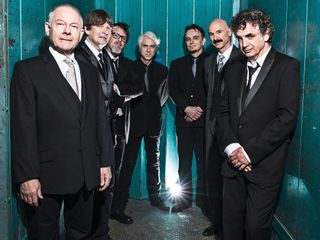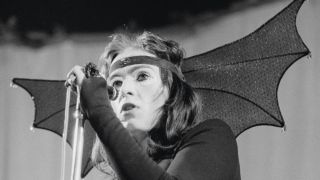I’ve just witnessed one of the most reassuring tableaus anywhere in the rock world; a metal band doing a photo shoot in a graveyard.
The location in question was Philadelphia’s Laurel Cemetery; the resting place for a significant number of notable American writers, poets, civil war heroes (on both sides), and even baseball hall of fame broadcaster, Harry Kalas. It reminded me very much of the Père Lachaise** **cemetery in the east of Paris, with its hills and gothic mausoleums but minus the teens crowding the graffiti spattered grave of Jim Morrison or the aesthetes loitering earnestly by the monuments to Oscar Wilde or Voltaire.
The photographer and metal band in question seemed to be wrapping up their business for the day and as I wandered between the headstones pulling the world’s laziest greyhound behind me, I feigned interest in the names of the departed while secretly eavesdropping upon their conversation.

‘Did you get the MP3s I sent you?’ inquired a lanky blonde guy, to a petite red headed girl which I assumed was the singer.
‘No I didn’t. Was it a link to your dropbox?’ replied the girl. She clutched what looked like a plastic skull to her chest with one hand while adjusting her bustle with the other.
‘Yeah it was and I posted them on Soundcloud too.’ the blonde guy said in a somewhat defensive tone. The red head pondered this for a moment and then replied perkily,
‘I’ll ask my dad to find them. He’s in IT.’
This is metal in the 21st century. Satan must be so proud.
The encounter brought home to me that at every level of the music business, image remains a significant cog in the machine, probably even more so in this age of because image and album art are struggling to survive in a world powered by iOS and Android. This got me thinking about Progressive Rock and how the genre has slowly but surely modified its visual identity over the years.
Back in the 70s, if you were a major progressive rock act, you had money behind you and significant promotional resources from which to draw upon. You also had a public who was willing to indulge your experimentation both musically and visually until you discovered something that resonated.
Packaging was king and how you looked as an artist or band, helped to define that package. This was a world dominated by Roger Dean and Hipgnosis after all and you couldn’t move five inches in a record store without encountering a cornucopia of alien landscapes and esoteric photographic imagery.
Some like Gabriel in Genesis or Wakeman during his solo album heyday, courted shock tactics by dressing up in outlandish costumes and stage theatrics. Others like Camel or the Floyd, sought to become personally anonymous, relying on either the grand narrative of the music or an impressive stage show (often both), to capture the imaginations of their fans. Either route depended upon the sense of spectacle and occasion. Your image helped to make you stand out from the crowd and standing out from the crowd was everything.
Today, the world is a very different place indeed. When all that is left for a band to let people know who they are is a space 300x300 pixels square, you have to get pragmatic in a hurry and relay the essential information as best you can.
Perhaps as a result of this change, the image of many modern progressive acts (who aren’t openly tribute artist) is a much more conservative affair. Gone is the complex and layered canvas of old and in its place are bands that seem to center upon sensible clothes and earnest, clear-eyed expressions, while standing somewhere industrial or old.

(Pic: Scarlet Page)
It’s a tactic that has proven fruitful for a host of modern artists like Radiohead, Muse, Steven Wilson and Devin Townsend. Even the grand old dame of Prog that is King Crimson, has adopted a thoroughly modern aesthetic and now sport finely tailored suits and tasteful evening attire for both promo shots and the stage.
There are naturally exceptions to this rule. Big Elf are justifiably proud of their 70s swagger and the UK’s Chrome Hoof sport a level of outlandish stage apparel that perhaps only The Tubes in their heyday could compete with.
Sadly, these appear to be the outliers in an increasingly visually bland bell curve, yet all may not be completely lost. With the resurgence of vinyl and the quiet renaissance of the boutique record store both here and in the UK, there might be a glimmer of hope for an industry that used to live and die upon the big picture mentality and exploring the alternative. More and more acts are returning to the twelve inch form factor and rediscovering that with it, their image and indeed creative aspirations, are beginning to flower once again.
While no one is expecting Steven Wilson to dress in a cape and wave a trident gleefully at an audience any time soon, the man has always been a subtle master of innovation, especially concerning packaging. Marillion too, while discarding the jester many years previously, have long recognized that their history and collective identity, resonates with fans and understand the lost art of repeat custom is to make the purchase of a record a magical event for the buyer.
Neither is an ebullient outpouring of otherworldly strangeness but both possess a hefty dose of original intent and that my friend, is what we are all here for.

(Pic: Scarlet Page)
Sadly it has to be said, this enlightened way of thinking is not reaching everybody. Back at the Cemetery, the photographer and metal band are climbing into two large 4x4s.
‘I’m ordering a pizza.’ announced the tall blonde gent. ‘Does anyone else want one?’ I didn’t hear any replies but that might have been because the doors had been slammed shut and the vehicles were powering away towards Kelly Drive.
I turned to my dog, Dora and said ‘Do you think they’ll become famous and talked about because of this photo shoot?’ Dora seemingly thought about this for a moment and then wizzed on the path.
I tend to agree with her.


